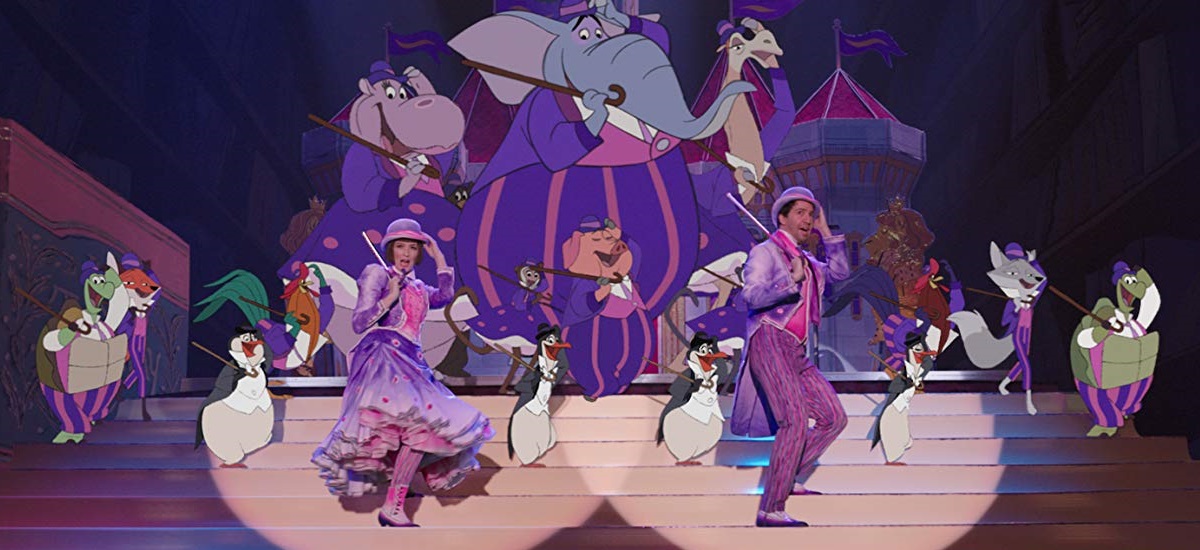One of the most difficult undertakings, in the world of cinema, is the task of making a sequel to a beloved film. Second most difficult, is making a sequel to a beloved film, that takes over five decades to get into theaters. A feat has very rarely been attempted. When that product in question is something as loaded with talent as Mary Poppins Returns is, a fair bit of trepidation is expected. Though it coasts by mostly on effortless charm, there’s a fair share of problems that keep it from being an instant classic.
Around 20 years after she first popping in on the Banks family, Mary Poppins (Blunt) arrives in another time of need. While the outside of 17 Cherry Tree Lane appear the same, things inside aren’t as recognizable. Michael (Ben Whishaw) has inherited the house from his sadly departed parents. He’s attempting to raise 3 children, with help from sister Jane (Emily Mortimer). All while struggling to recover from the passing of his wife. Worse yet, he’s two months behind on the rent. That’d be forgivable in most other circumstances, but a depression rages (“The Big Slump”, the movie dubs it) on the streets of London. He’s given a week, by the his boss (Colin Firth) to settle up. Either by pay in full or proving that his father left him shares in the bank. If he fails, he forfeits the home. A little bit of magic may just fix everything.

Mary sets about looking after the Banks family, in a manner that’s both similar to and entirely divorced from that of her previous trip. The two oldest children, Anabel (Pixie Davies) and John (Nathanael Saleh), have been forced to grow up quickly, in the past year. Meanwhile, George (Joel Dawson) has mostly kept his head in the clouds. So she invests in helping them reclaim their sense of wonder. There’s an undersea voyage to be had. An army of leeries to dance and sing with. A quick beautiful 2D jaunt through a China bowl. Not to mention a set piece involving Big Ben that would make Cher blush. Children are sure to be awestruck. She’s accompanied on these various adventures by lamplighter, Jack (Lin Manuel-Miranda). In a film that continually engages in an endless stream of call backs, he conveniently remembers Mary Poppins form all those years ago.
Let’s get this much out of the way: Emily Blunt is absolutely sublime as Mary Poppins. Giving the character her own little twist, Mary appears by turns snarkier and more whimsical than ever before. Never falling into an impersonation, she differentiates and distances herself nicely from Julie Andrews. While always treating the character with the utmost respect and poise. Blunt simply works wonders with the greatest of ease. Manuel-Miranda is able to match her, in terms of charm, as he dons an odd accent, that somehow puts Dick Van Dyke’s to shame. If only every thing else that surrounds them were so practically perfect in every way.

Part of what dictates how much one enjoys Mary Poppins Returns, is tied to how they feel about director Rob Marshall. Successfully adapting Broadway luminaries like Chicago and Into The Woods from the small stage to the big screen in the past, makes him appear to be right man for the job. Yet, he also made Nine
, a film that was almost entirely forgotten about upon release. Marshall can’t decide if his film should replicate the sound stage quality of the original, the stage setting of a classic musical, or using all of London, as a canvas. His lack of commitment is often jarring. At the same time, it’s easy to imagine audiences being spellbound by the transitions. Specially when he opens the film with the showstopping (Underneath the) Lovely London Sky, juggling everything with ease. Something not so easily accomplished later on.
Speaking of songs, there’s probably a conversation that’ll arise, surrounding Marc Shaiman and Scott Wittman’s varying degrees of success. Some numbers are absolute scorchers, such as The Place Where Lost Things Go or A Conversation. Others rely too much on a “try hard” approach. Constantly wanting to outdo its predecessor’s memorable ditties, most of which by now has become part of the cultural lexicon. Answering that beck and call renders Mary Poppins Returns a slog at times. Continually attempting to play a game of one-upmanship with a disinterested shadow. The biggest number, Trip A Little Light Fantastic, showcases the best and worst of what’s on offer. Though it needlessly adds on more disparate pieces, to a tune that was catch enough on it’s own. Should the phrase “and then came the BMX bikers…” raise an eyebrow or two, you can get a sense of how things go off the rails.

It’s difficult looking at a picture such as Mary Poppins Returns with an overly critical eye. Specially when all the film wants to do is delight audiences. Many times it succeeds with great ease. Even suggesting that Disney should pursue the idea of making a hand drawn animated feature, in the near future. Ultimately, what threatens to all the good will it musters up, is a sense of preying upon nostalgia. When it gets bogged down in attempting to out do its predecessor, things screech to a halt. Almost if the creative team needs their own Mary on hand to instill them with a dose of confidence. If you squint hard enough, long enough and tilt your head just right, you might just be reminded why it’s a jolly holiday with Mary. An effort that shouldn’t be required by a film that wants to be so effortlessly enjoyable



